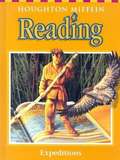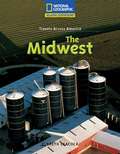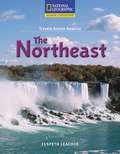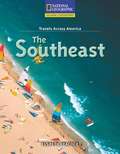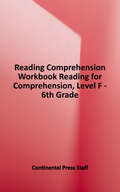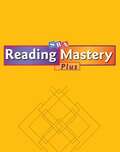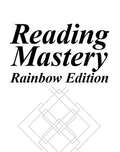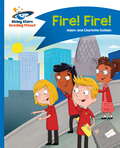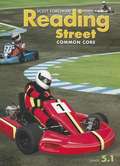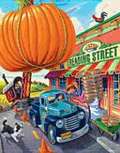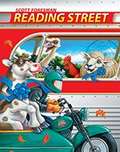- Table View
- List View
Reading Expeditions
by J. David Cooper John J. PikulskiThis book combines poems, stories, plays, personal essays, and articles that add new perspectives on the theme or subject matter of the longer work.
Reading Expeditions: The Midwest
by Linda HoytThe Midwestern region of the United States includes Minnesota, Wisconsin, Michigan, Nebraska, Ohio, Indiana, Illinois, Missouri, Iowa, Kansas, South Dakota, and North Dakota. Readers learn why the Midwest is flat and familiarize themselves with other features of the landscape as they tour the Great Lakes, the Ohio and Missouri Rivers, the Great Plains, the Badlands, and Wind and Jewel Caves. Students learn that the economy of the Midwest consists of "belts" from the Corn Belt to the Dairy Belt to the Manufacturing Belt.
Reading Expeditions: The Northeast
by Linda HoytThe Northeast region of the United States includes Maryland, Delaware, New Jersey, Pennsylvania, New York, Connecticut, Rhode Island, Massachusetts, Vermont, New Hampshire, Maine, and the District of Columbia. Land features of the Northeast region include coastal plains, rocky coastlines, and mountains. The Northeast economy depends heavily on the region's natural resources. Industries include shipping, timber, fishing, manufacturing, and tourism. Tourists to the Northeast region come to hike, swim, ski, camp, and to visit many historical and cultural sights, including the many Smithsonian museums in Washington, D.C.
Reading Expeditions: The Southeast
by Linda HoytThis guided tour helps students explore the Southeast, which includes the states of Kentucky, West Virginia, Virginia, Tennessee, North Carolina, South Carolina, Georgia, Alabama, Mississippi, Louisiana, Arkansas, and Florida. Students begin the tour looking at land and water features of the region--the Mississippi River and its delta, the Piedmont, Appalachian Mountains, and the coastal plains.
Reading For Comprehension: Level F
by Continental Press StaffHow does an IMAX movie work? With level F of Reading for Comprehension, your students will learn all about this kid-friendly topic and many more. This book for grade 6 students includes 46 high-interest, nonfiction articles with questions that reinforce key reading and writing skills commonly found on state tests. Multiple-choice questions test these reading skills: vocabulary, main idea and details, sequence, cause and effect, and inferences and conclusions. Students also answer open-ended questions to practice writing narrative text, descriptive text, persuasive text, and expository text.
Reading Instruction That Works, Fourth Edition: The Case for Balanced Teaching
by Michael Pressley Richard L. AllingtonThis widely adopted text and K-8 practitioner resource demonstrates how successful literacy teachers combine explicit skills instruction with an emphasis on reading for meaning. Distinguished researcher Richard L. Allington builds on the late Michael Pressley's work to explain the theories and findings that guide balanced teaching and illustrate what exemplary lessons look like in action. Detailed examples offer a window into highly motivating classrooms around the country. Comprehensive in scope, the book discusses specific ways to build word recognition, fluency, vocabulary, and comprehension, especially for readers who are struggling. New to This Edition *Updated throughout to reflect important recent research advances. *Chapter summing up the past century's reading debates and the growing acceptance of balanced teaching. *New and revised vignettes of exemplary teachers.
Reading Mastery Plus Workbook (Level #5)
by Siegfried Engelmann Jean Osborn Steve Osborn Leslie ZorefReading Mastery contains questions and illustrations to help students become better readers.
Reading Mastery Plus: Textbook A
by Sra Publications StaffThis level five textbook offers engaging reading opportunities that strengthen reading skills.
Reading Mastery VI: Textbook (Rainbow Edition)
by Siegfried Engelmann Jean Osborn Steve Osborn Leslie ZorefA selection of poems, stories, articles and other writings will help you become a better reader.
Reading Nonfiction: Notice and Note Signposts and Questions
by Kylene Beers Robert E. Probst"When students recognize that nonfiction ought to challenge us, ought to slow us down and make us think, then they're more likely to become close readers." That means we need to help them question texts, authors, and, ultimately, their own thinking. No matter the content area, with Reading Nonfiction's classroom-tested suggestions, you'll lead kids toward skillful and responsible disciplinary literacy. <P><P> Picking up where their smash hit Notice & Note left off, Kylene Beers and Bob Probst write: "Fiction invites us into the writer's imagined world; nonfiction intrudes into ours and purports to tell us something about it." This crucial difference increases the responsibility of the nonfiction reader, so Kylene and Bob have developed interlocking scaffolds that every student can use to go beyond a superficial reading: <P><P> <li>3 essential questions that set students up for closer, more attentive readings of nonfiction texts <li>5 Notice & Note nonfiction signposts that cue kids to apply the skills and processes that sophisticated readers use instinctively <li>7 proven strategies readers can use to clear up confusions when the text gets tough. <P><P> We all know the value of helping students define nonfiction and understand its text structures. Reading Nonfiction goes the next crucial step-helping kids challenge the claims of nonfiction authors, be challenged by them, and skillfully and rigorously make up their mind about purported truths.
Reading Planet - Fire! Fire! - Blue: Comet Street Kids
by Adam Guillain Charlotte GuillainComet Street Kids reading books follow the adventures of Rav, Asha, Tess and Finn, four of the residents of Comet Street. There are 72 exciting stories in the series that children won't be able to put down. It's time for the school trip ? to the Monument in London! The class are going to find out all about the Great Fire of London, but Tess thinks she's going to see a real fire. After climbing the 311 steps to the top, will she? Reading age: 5-6 years
Reading Street
by Candy Dawson Boyd Sharon Vaughn Camille Blachowicz Wendy Cheyney Connie Juel Edward Kame'Enui Donald Leu Jeanne Paratore Sam Sebesta Deborah Simmons Susan Watts-Taffe Karen Kring Wixson Peter Afflerbach P. David PearsonNIMAC-sourced textbook
Reading Street
by Candy Dawson Boyd Sharon Vaughn Camille Blachowicz Wendy Cheyney Connie Juel Edward Kame'Enui Donald Leu Jeanne Paratore Sam Sebesta Deborah Simmons Susan Watts-Taffe Karen Kring Wixson Peter Afflerbach P. David PearsonNIMAC-sourced textbook
Reading Street 5.1
by Scott ForesmanMeeting Challenges Doing Right the Thing Inventors and Artists.
Reading Street [Grade 5 Unit 1]
by Candy Dawson Boyd Sharon Vaughn Camille Blachowicz Wendy Cheyney Connie Juel Edward Kame'Enui Donald Leu Jeanne Paratore Sam Sebesta Deborah Simmons Susan Watts-Taffe Karen Kring Wixson Peter Afflerbach P. David PearsonNIMAC-sourced textbook
Reading Street [Grade 5.1]
by Candy Dawson Boyd Sharon Vaughn Camille Blachowicz Connie Juel Edward Kame'Enui Donald Leu Sam Sebesta Deborah Simmons Karen Kring Wixson Peter Afflerbach P. David Pearson Jeanne R. Paratore Elena Izquierdo Alfred Tatum Susan Watts TaffeNIMAC-sourced textbook
Reading Street [Grade 5.1]
by Candy Dawson Boyd Sharon Vaughn Camille Blachowicz Connie Juel Edward Kame'Enui Donald Leu Sam Sebesta Deborah Simmons Karen Kring Wixson Peter Afflerbach P. David Pearson Jeanne R. Paratore Elena Izquierdo Alfred Tatum Susan Watts TaffeNIMAC-sourced textbook
Reading Street [Grade 5.1]
by Candy Dawson Boyd Sharon Vaughn Camille Blachowicz Connie Juel Edward Kame'Enui Donald Leu Sam Sebesta Deborah Simmons Karen Kring Wixson Peter Afflerbach P. David Pearson Jeanne R. Paratore Elena Izquierdo Alfred Tatum Susan Watts TaffeNIMAC-sourced textbook
Reading Street [Grade 5.2]
by Candy Dawson Boyd Sharon Vaughn Camille Blachowicz Connie Juel Edward Kame'Enui Donald Leu Sam Sebesta Deborah Simmons Karen Kring Wixson Peter Afflerbach P. David Pearson Jeanne R. Paratore Elena Izquierdo Alfred Tatum Susan Watts TaffeNIMAC-sourced textbook
Reading Street [Grade 5.2]
by Candy Dawson Boyd Sharon Vaughn Camille Blachowicz Connie Juel Edward Kame'Enui Donald Leu Sam Sebesta Deborah Simmons Karen Kring Wixson Peter Afflerbach P. David Pearson Jeanne R. Paratore Elena Izquierdo Alfred Tatum Susan Watts TaffeNIMAC-sourced textbook
Reading Street [Grade 5]
by Candy Dawson Boyd Sharon Vaughn Camille Blachowicz Wendy Cheyney Connie Juel Edward Kame'Enui Donald Leu Jeanne Paratore Sam Sebesta Deborah Simmons Susan Watts-Taffe Karen Kring Wixson Peter Afflerbach P. David PearsonNIMAC-sourced textbook
